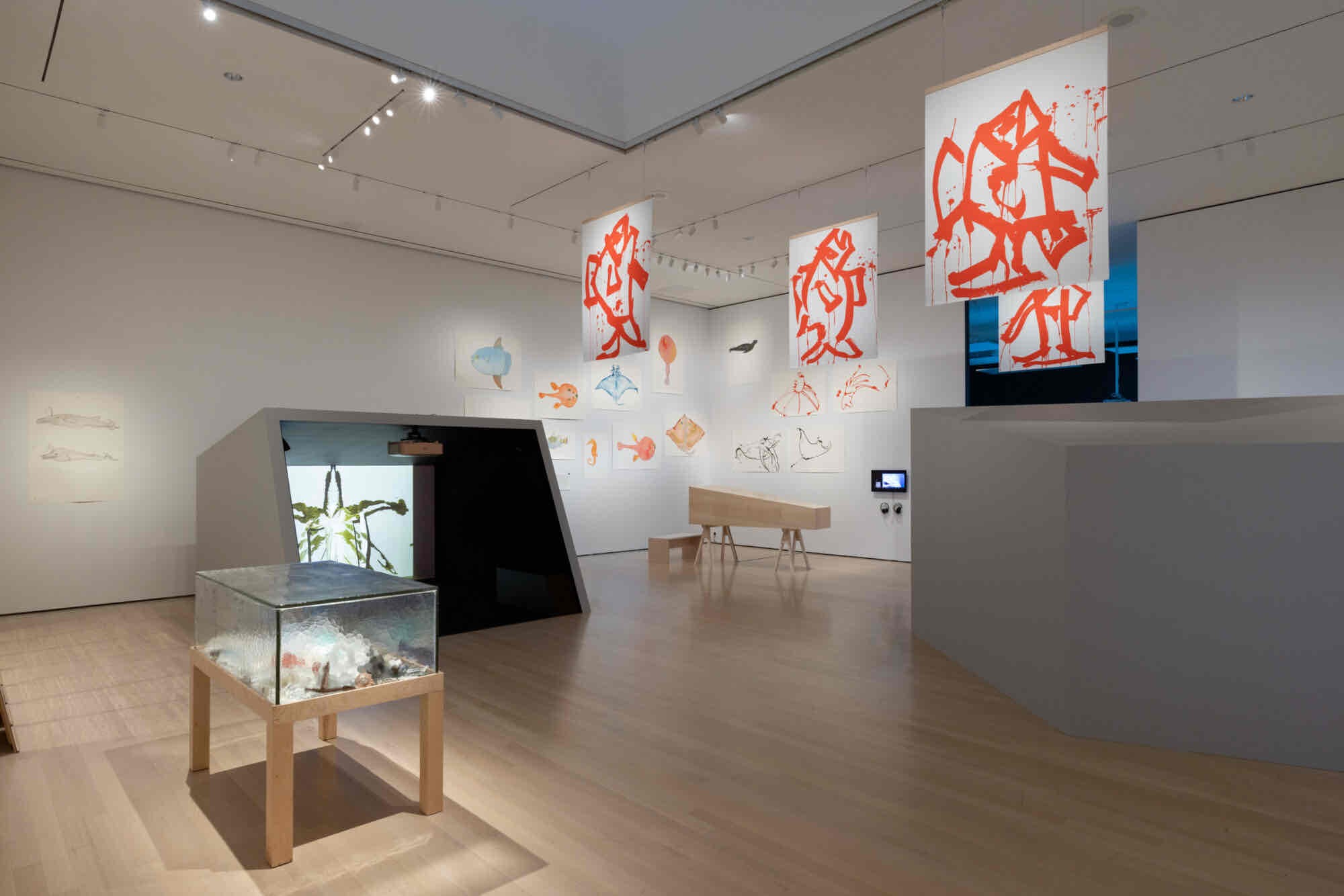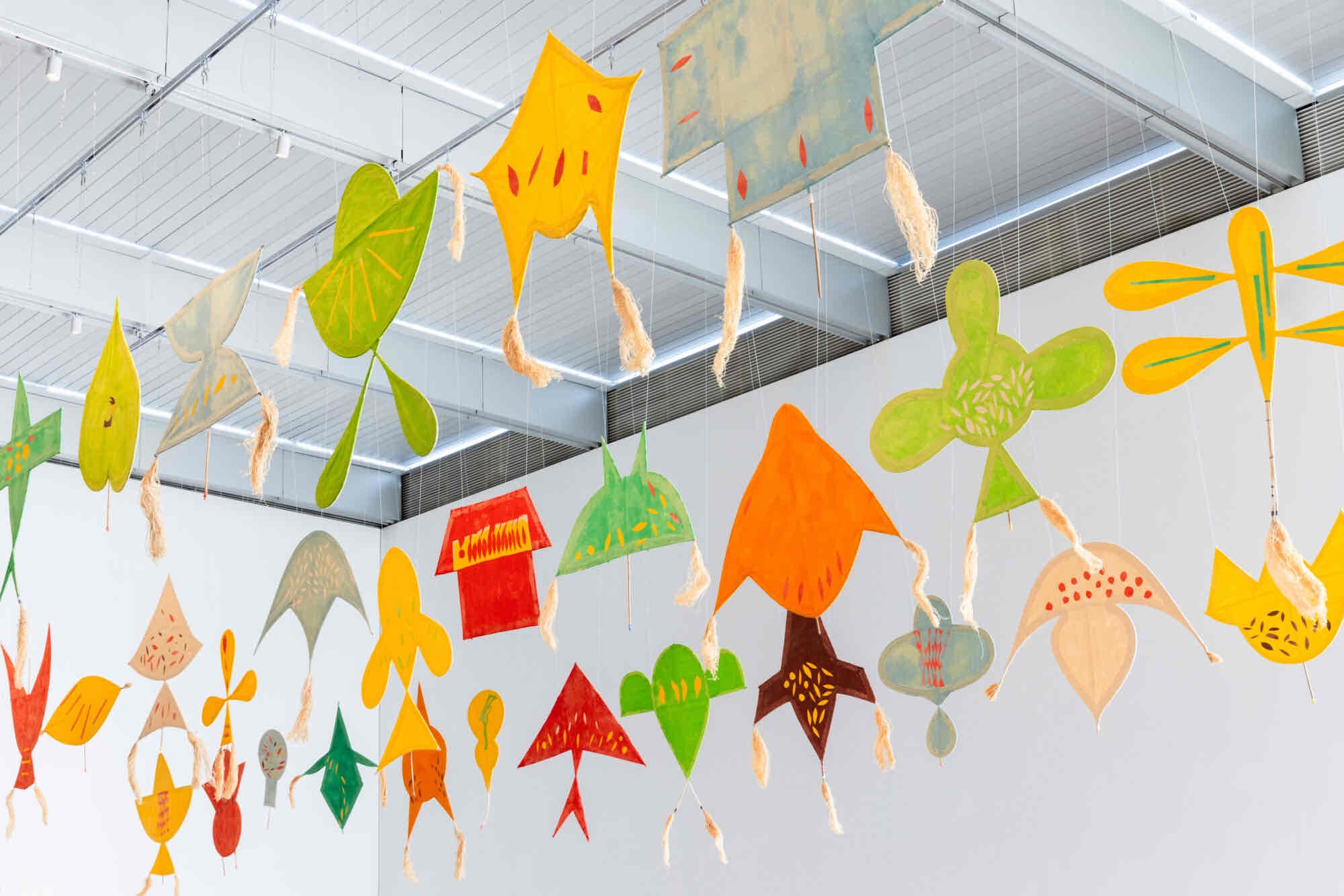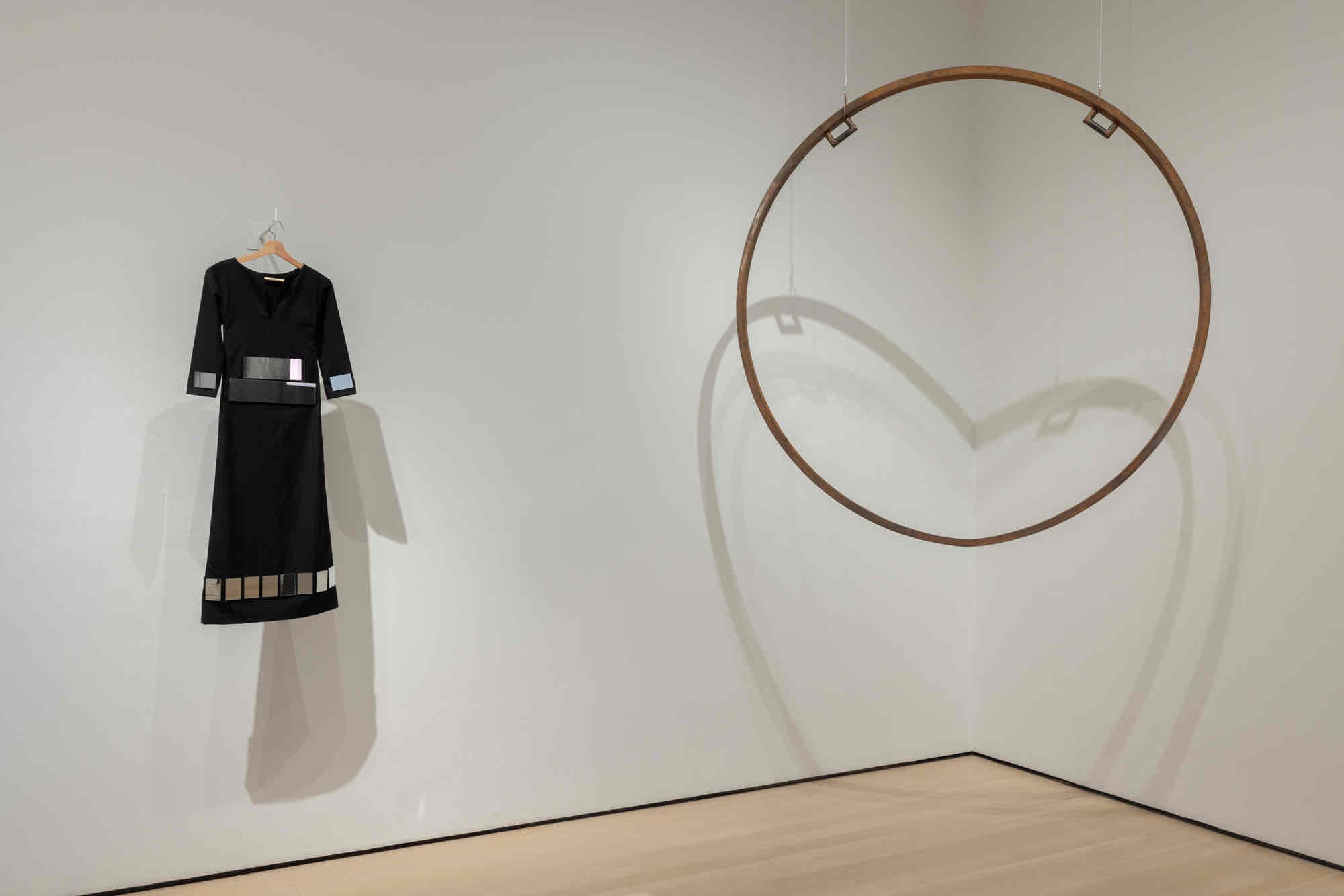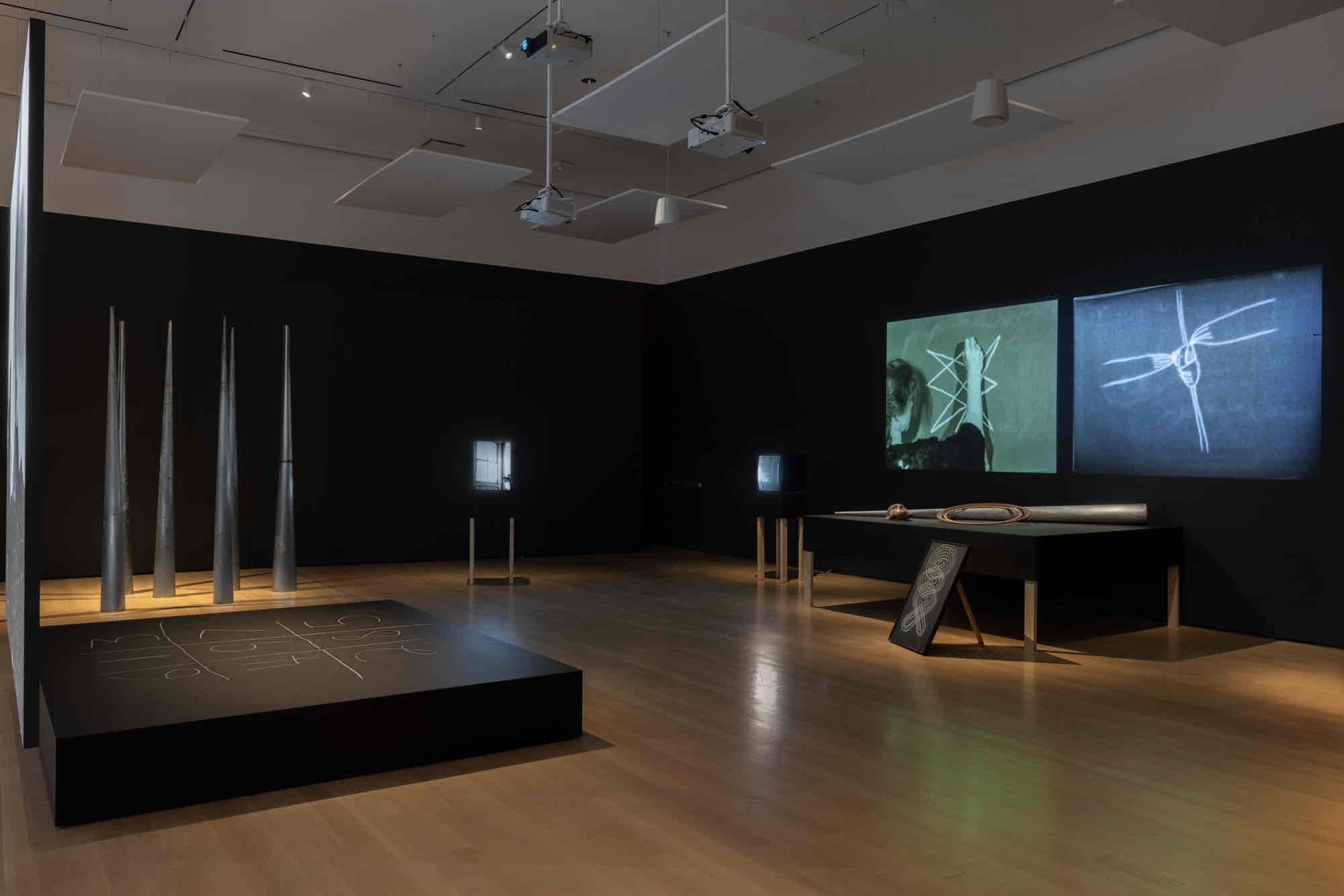Joan Jonas
Good Night Good Morning
17 Mar - 06 Jul 2024

Installation view of Joan Jonas: Good Night Good Morning, The Museum of Modern Art, New York, March 17–July 6, 2024. Photo: Jonathan Dorado

Installation view of Joan Jonas: Good Night Good Morning, The Museum of Modern Art, New York, March 17–July 6, 2024. Photo: Jonathan Dorado

Installation view of Joan Jonas: Good Night Good Morning, The Museum of Modern Art, New York, March 17–July 6, 2024. Photo: Jonathan Dorado

Installation view of Joan Jonas: Good Night Good Morning, The Museum of Modern Art, New York, March 17–July 6, 2024. Photo: Jonathan Dorado

Installation view of Joan Jonas: Good Night Good Morning, The Museum of Modern Art, New York, March 17–July 6, 2024. Photo: Jonathan Dorado

Installation view of Joan Jonas: Good Night Good Morning, The Museum of Modern Art, New York, March 17–July 6, 2024. Photo: Jonathan Dorado

Installation view of Joan Jonas: Good Night Good Morning, The Museum of Modern Art, New York, March 17–July 6, 2024. Photo: Jonathan Dorado

Installation view of Joan Jonas: Good Night Good Morning, The Museum of Modern Art, New York, March 17–July 6, 2024. Photo: Jonathan Dorado

Installation view of Joan Jonas: Good Night Good Morning, The Museum of Modern Art, New York, March 17–July 6, 2024. Photo: Jonathan Dorado

Installation view of Joan Jonas: Good Night Good Morning, The Museum of Modern Art, New York, March 17–July 6, 2024. Photo: Jonathan Dorado
The Museum of Modern Art presents Joan Jonas: Good Night Good Morning, the artist’s most comprehensive retrospective in the United States, spanning more than 50 years of her remarkable career. On view from March 17 through July 6, 2024, in the Steven and Alexandra Cohen Center for Special Exhibitions, the exhibition features a selection of works produced from 1968 through the present, including videos, drawings, photographs, and major installations and performances—many of which have been revisited and reconfigured by the artist on the occasion of this exhibition. Joan Jonas: Good Night Good Morning also presents extensive corresponding archival materials.
“It’s been exciting to reconsider old and newer works as they relate in a new context. I am very happy to have the work on exhibition in New York, where I have lived most of my life,” said Jonas, who is working closely with the curatorial team.
“This highly anticipated exhibition will give an overview of Jonas’s unique role as a trailblazing figure of video and performance and her enduring multimedia legacy for generations of younger artists. It will trace the development of Jonas’s career, from works made in the 1960s and 1970s exploring the confluence of technology and ritual to more recent ones dealing with ecology and the landscape,” said Janevski. “The exhibition also advances the Museum’s commitment to representing the work of key women artists whose practices have been deeply influential in the history of performance, media, and feminist art practices.”
Jonas began her career as a sculptor, and it was not until attending workshops with choreographers from Judson Dance Theater in the late 1960s that she would refocus her artistic practice on experimentation with performance and technology. Organized chronologically, this retrospective highlights four major themes that are present throughout Jonas’s multidisciplinary body of work: performance, technology, literature, and ecology. The exhibition also foregrounds how Jonas uses her own works as archival material—with each project building on those that preceded it—often transforming and restaging them into other mediums.
Joan Jonas: Good Night Good Morning opens with a 16mm film projection of Wind (1968), which introduces many of Jonas’s interests, such as performing for the camera, the impact of natural phenomena, and the use of mirrors as a method of manipulating and fragmenting space. These themes are tracked throughout the course of the exhibition, particularly in early performances from the 1960s and ’70s that were set in New York City’s downtown lofts, piers, empty lots, and public beaches and are highlighted in the first gallery. In the photo documentations of Mirror Piece I (1969) and Mirror Piece II (1970), performers carrying mirrors in choreographed sequences, reflecting the audience and incorporating them into the space of the action. Jonas deployed the mirror as a viewing device, prop, and tool for reflecting upon identity and self-perception.
The exhibition also outlines the artist’s use of newly available technology at the beginning of the 1970s, like the Sony Portapak camera used in the artist’s first video-performance, Organic Honey’s Visual Telepathy (1972). In this work, Jonas considered the monitor as an ongoing mirror—her alter-ego Organic Honey’s performance for the camera harnessed technology’s ability to record and display content in real time. The retrospective offers a new version of the installation Organic Honey’s Visual Telepathy/Organic Honey’s Vertical Roll adapted to MoMA’s space, reinvigorating Jonas’s contemporary legacy in the fields of video, installation, performance, and feminist art.
Cross-media installations throughout the retrospective provide insight into Jonas’s unique working method, including the artist’s multilayered translation process from one medium to another—from performance through video to installation. For example, Mirage (1976/1994/2005/2019)—a work in MoMA’s collection, on view in the third gallery of the exhibition—began in 1976 as a performance at New York’s Anthology Film Archives. There, Jonas used film, video, drawing, and props to evoke rituals. In 1994, the artist reimagined the work as an installation consisting of sculptural elements, chalkboard drawings, videos, and documentation of the original performance—which she then reconfigured at MoMA in 2005 and 2019, and has revisited again for this exhibition.
Since the late 1960s, the artist has drawn inspiration from fables, ancient myths, folklore, and poetry, which form the groundwork for important works like The Juniper Tree (1976/1994), on view in the next gallery. A large-scale performance installation based on the Brothers Grimm’s written version of the eponymous story, this work’s audio recording of the artist retelling the fairytale demonstrates Jonas’s interest in oral traditions and narratives told by women about their roles in society.
The following gallery also features Volcano Saga (1987), in which Jonas continues her interest in literature and reinterprets the Laxdaela Saga, a 13th-century Icelandic folktale. Initially realized as a performance, the video version on view in the exhibition was realized in 1989 and features the actors Tilda Swinton and Ron Vawter. The following gallery displays materials showing Jonas’s processes of working, collecting, and teaching. A selection of Jonas’s teaching notes and video collaborations with students are key examples of her crucial role as an educator. This collection of objects also spotlights the importance of performance props in Jonas’s works. Most of these objects were bought in an antique store in Cape Breton, Nova Scotia, Canada, where the artist spent yearly summers and whose natural scenery spurred her fascination with landscape and ecology, key themes in the exhibition and throughout the artist’s body of work.
Joan Jonas: Good Night Good Morning is organized by Ana Janevski, Curator, with Lilia Rocio Taboada and Gee Wesley, Curatorial Assistants, Department of Media and Performance.
“It’s been exciting to reconsider old and newer works as they relate in a new context. I am very happy to have the work on exhibition in New York, where I have lived most of my life,” said Jonas, who is working closely with the curatorial team.
“This highly anticipated exhibition will give an overview of Jonas’s unique role as a trailblazing figure of video and performance and her enduring multimedia legacy for generations of younger artists. It will trace the development of Jonas’s career, from works made in the 1960s and 1970s exploring the confluence of technology and ritual to more recent ones dealing with ecology and the landscape,” said Janevski. “The exhibition also advances the Museum’s commitment to representing the work of key women artists whose practices have been deeply influential in the history of performance, media, and feminist art practices.”
Jonas began her career as a sculptor, and it was not until attending workshops with choreographers from Judson Dance Theater in the late 1960s that she would refocus her artistic practice on experimentation with performance and technology. Organized chronologically, this retrospective highlights four major themes that are present throughout Jonas’s multidisciplinary body of work: performance, technology, literature, and ecology. The exhibition also foregrounds how Jonas uses her own works as archival material—with each project building on those that preceded it—often transforming and restaging them into other mediums.
Joan Jonas: Good Night Good Morning opens with a 16mm film projection of Wind (1968), which introduces many of Jonas’s interests, such as performing for the camera, the impact of natural phenomena, and the use of mirrors as a method of manipulating and fragmenting space. These themes are tracked throughout the course of the exhibition, particularly in early performances from the 1960s and ’70s that were set in New York City’s downtown lofts, piers, empty lots, and public beaches and are highlighted in the first gallery. In the photo documentations of Mirror Piece I (1969) and Mirror Piece II (1970), performers carrying mirrors in choreographed sequences, reflecting the audience and incorporating them into the space of the action. Jonas deployed the mirror as a viewing device, prop, and tool for reflecting upon identity and self-perception.
The exhibition also outlines the artist’s use of newly available technology at the beginning of the 1970s, like the Sony Portapak camera used in the artist’s first video-performance, Organic Honey’s Visual Telepathy (1972). In this work, Jonas considered the monitor as an ongoing mirror—her alter-ego Organic Honey’s performance for the camera harnessed technology’s ability to record and display content in real time. The retrospective offers a new version of the installation Organic Honey’s Visual Telepathy/Organic Honey’s Vertical Roll adapted to MoMA’s space, reinvigorating Jonas’s contemporary legacy in the fields of video, installation, performance, and feminist art.
Cross-media installations throughout the retrospective provide insight into Jonas’s unique working method, including the artist’s multilayered translation process from one medium to another—from performance through video to installation. For example, Mirage (1976/1994/2005/2019)—a work in MoMA’s collection, on view in the third gallery of the exhibition—began in 1976 as a performance at New York’s Anthology Film Archives. There, Jonas used film, video, drawing, and props to evoke rituals. In 1994, the artist reimagined the work as an installation consisting of sculptural elements, chalkboard drawings, videos, and documentation of the original performance—which she then reconfigured at MoMA in 2005 and 2019, and has revisited again for this exhibition.
Since the late 1960s, the artist has drawn inspiration from fables, ancient myths, folklore, and poetry, which form the groundwork for important works like The Juniper Tree (1976/1994), on view in the next gallery. A large-scale performance installation based on the Brothers Grimm’s written version of the eponymous story, this work’s audio recording of the artist retelling the fairytale demonstrates Jonas’s interest in oral traditions and narratives told by women about their roles in society.
The following gallery also features Volcano Saga (1987), in which Jonas continues her interest in literature and reinterprets the Laxdaela Saga, a 13th-century Icelandic folktale. Initially realized as a performance, the video version on view in the exhibition was realized in 1989 and features the actors Tilda Swinton and Ron Vawter. The following gallery displays materials showing Jonas’s processes of working, collecting, and teaching. A selection of Jonas’s teaching notes and video collaborations with students are key examples of her crucial role as an educator. This collection of objects also spotlights the importance of performance props in Jonas’s works. Most of these objects were bought in an antique store in Cape Breton, Nova Scotia, Canada, where the artist spent yearly summers and whose natural scenery spurred her fascination with landscape and ecology, key themes in the exhibition and throughout the artist’s body of work.
Joan Jonas: Good Night Good Morning is organized by Ana Janevski, Curator, with Lilia Rocio Taboada and Gee Wesley, Curatorial Assistants, Department of Media and Performance.
